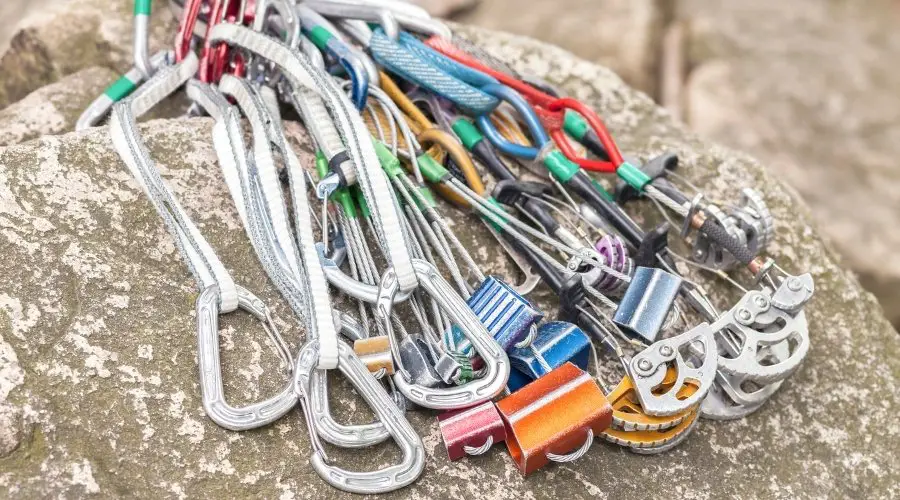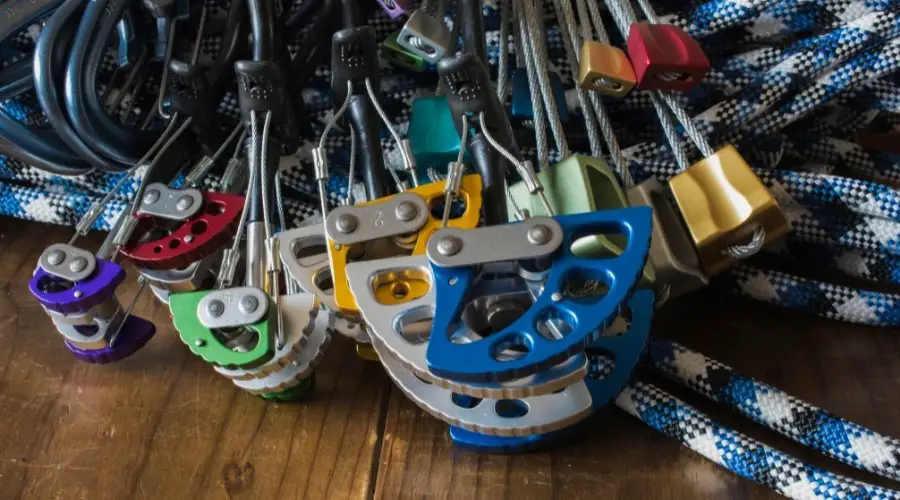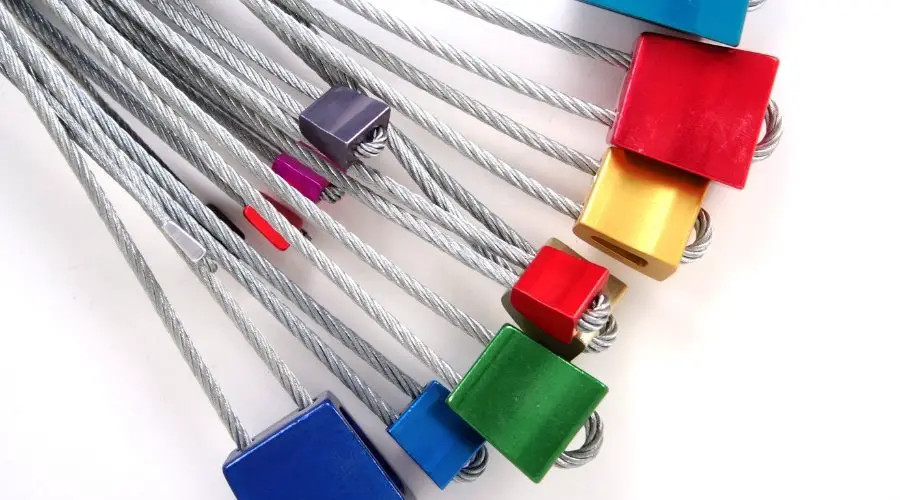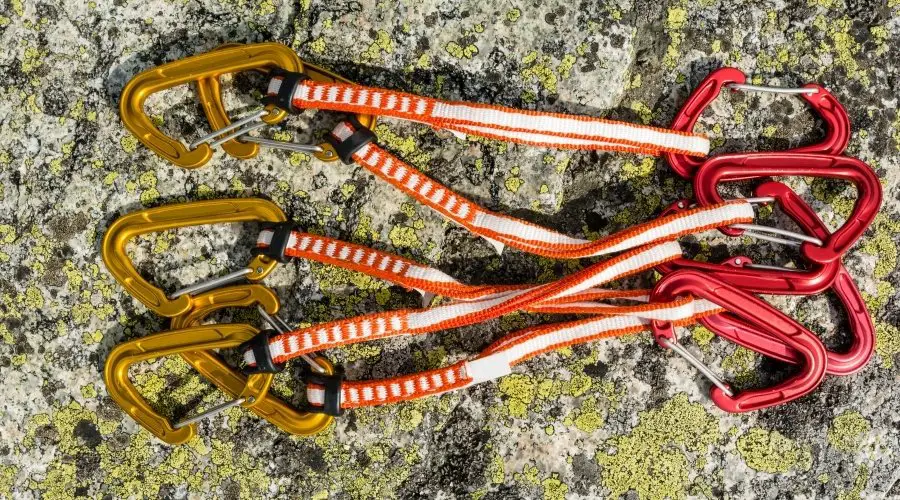Putting together your first trad rack is not an exact science and can get very expensive really quick. Due to its expensive nature, most climbers typically get a very basic trad rack to start and then add onto it as they progress and have a better idea as to what gear they want. The average cost of a trad rack can range quite significantly.
On average, a typical starter trad rack will cost anywhere between $720 and $965. Included in this cost is a set of 5 cams, 10 nuts, 4 quickdraws, 8 slings, 24 non-locking carabiners, 4 locking carabiners, and a nut tool. Purchasing additional gear will increase the total cost of the rack.
The amount of gear in a standard trad rack is not an exact science and many climbers will have a different opinion of what a “full rack” includes. The amount of gear listed above was not chosen at random. Having the gear on that list will allow you to climb the majority of entry-level trad climbs when starting out. This article explains why each piece of gear above is needed and how much you can expect to pay for it.
Starter Trad Rack Gear List and Average Cost

The absolute best way to build your rack is to reach out to experienced climbers in your area and see what gear they recommend. Some areas will have a lot of finger cracks and require additional small protection whereas others may have more off-widths that require larger protection. By talking to the climbers in your area, you can ensure that you are not wasting your money on gear you will not need.
That said, there are some basic gear items that every trad climber should own. The table below details a basic starter trad rack and the expected cost for each gear item. The total cost of the rack will increase or decrease based on the gear you already own and the quality/quantity that you decide to purchase.
| Trad Gear | Amount Needed | Average Cost |
| Cams | 5 (sizes 0.5 through 3) | $300 to $400 |
| Nuts/Stoppers | 10 (sizes 4 through 13) | $100 to $150 |
| Quickdraws | 4 | $50 to $75 |
| Slings/Runners | 8 | $60 to $90 |
| Non-Locking Carabiners | 24 | $160 to $180 |
| Locking Carabiners | 4 | $40 to $50 |
| Nut Tool | 1 | $10 to $20 |
As detailed in the table above, an average trad rack will cost anywhere from $720 to $965 depending on the gear you purchase.
Unless you are doing big wall climbing or incredibly long multi-pitch routes right off the bat, you will not need to have a ridiculous amount of gear to get started. In fact, you should be going out with a very experienced climber who you trust or a certified guide when you are first beginning to trad climb.
Your guide will likely have a full rack and bring all of the gear needed. In addition to this, their knowledge will be integral in teaching you proper gear placement, helpful techniques, and all of the other skills you need to know while trad climbing.
The amount of each of these gear items and their expected cost is explained more below (these numbers were not chosen at random).
Cams – Amount and Average Cost for a Starter Trad Rack

The average beginner trad climber will not yet be a notch crack climber. Therefore, the majority of the routes they will be starting on will typically involve a lot of hand cracks. If you do not know the different crack sizes, please read my article here that details them and come back so you won’t be completely lost.
Due to this lack of crack climbing experience, most of the trad routes beginners will be climbing can be protected using moderate sized cams.
It should be noted that cams are not created the same size across manufacturers. for example, a #1 sized Black Diamond cam is a different physical size than a #1 sized cam made by a different manufacturer. What matters when choosing cam sizes is their effective range. To see how different cam sizes and effective ranges compare, check out MojaGear’s article here.
For a starter rack, you will want to have a cam set that covers an effective range of about 1 inch to 3.5 inches. These will be the most common crack widths you will run into when placing gear. Having a full set of moderate sized cams (Black Diamond sizes 0.5, 0.75, 1, 2, 3) will do the trick just fine.
On average, a decent set of 5 moderate sized cams will typically cost between $300 and $400. Purchasing a cam set instead of the cams individually will decrease the average cost per cam.
You do not need to own multiple cams of the same size just yet as you will be climbing with other climbers who also have gear. Eventually, you can add to your cam size range or double up on the size(s) you use the most. I recommend starting out with the Black Diamond Camalot C4 set (sizes .5 to 3). These are known to be fantastic for a reason. Check out their current price on Amazon linked here.
Nuts – Amount and Average Cost for a Starter Trad Rack

A good starter trad rack will have a full set of nuts (sizes 4 to 13). The smaller nut sizes (1, 2, and 3) are typically more beneficial for more advanced trad and alpine climbing. Typically, a starter rack will not need them. Before buying these, check to make sure you are in an area that will actually allow them to be used.
Nut sizes, just like cams, change based on the manufacturer. As such, you will want to look for nuts that cover an effective range of approximately 0.3 to 1.3 inches.
In addition to sizing, you will want ot look for nuts that are color coded. Color coded nuts will allow you to quickly and easily identify the correct size when you are placing gear. It is beneficial to minimize any time spent unnecessarily messing around with gear on the wall.
On average, a decent full set of 10 nuts will typically cost between $100 and $150. Purchasing a full nut set instead of smaller sets or individual nuts will decrease the average cost per nut.
I recommend to get the Black Diamond Anodized Stopper Set #4-13. They perform great and are color coded so you don’t have to spend a bunch of time trying to find the right size while pumped out hanging from your fingers. Check out their current price on Amazon here.
Quickdraws and Slings – Amount and Average Cost for a Starter Trad Rack

It is a good idea to have a few standard quickdraws with you while trad climbing because they are typically smaller and more compact than alpine draws. 4 quickdraws is a good amount to include in your rack.
By now, you likely have experience in sport climbing and own a set of quickdraws. If they are still in great shape and you don’t care about their weight too much, you can use these for your trad rack as well. That said, many trad climbers opt to get a few lightweight quickdraws that they can use when they don’t need to extend their protection.
On average, four quickdraws costs approximately $50 to $75. Most bulk quickdraw sets include six draws. I recommend to getting a complete set and rotating out the draws each session to extend their lifespan.
In addition to the standard 12cm quickdraws, you will need longer alpine draws in your rack. Alpine draws are typically made from two non-locking carabiners and a sling/runner ranging between 25cm to 240cm.
The most common size is a shoulder length sling (60cm). It is common to carry 2 slings longer than this as well (120cm or 240cm). The longer slings allow climbers to extend the distance between the rope and their protection.
For a starting trad rack, it is generally recommended to have eight 60cm slings for alpine draws.
On average, a decent set of eight 60cm slings costs approximately $60 to $90. The cost of slings generally increases with length.
Check out the current price of my favorite slings, the Black Diamond 10 mm Dynex Runner, on Amazon here and the current price of my favorite lightweight quickdraws, the Black Diamond HotWire, on Amazon here.
Carabiners – Amount and Average Cost for a Starter Trad Rack
The standard trad rack requires both non-locking and locking (screw) carabiners. The non-locking carabiners will be used for your alpine draws and to rack all of your gear. In general, you will want to have 16 biners for your alpine draws and another 8 for actually racking your gear. You may need more or less depending on your current rack size.
On average, a decent set of 24 non-locking climbing carabiners costs approximately $160 to $180.
The locking carabiners are needed for building anchors. Sometimes, they will be used to build the longer alpine draws as well. Best practice says to always bring along an extra locking carabiner for safety reasons.
Typically you will want to have at least 4 locking climbing carabiners in your rack. On average, a decent set of 4 locking climbing carabiners will cost between $40 and $50.
Check out the current price of my favorite locking carabiners, the Black Diamond HotForge Screwgate Carabiners, on Amazon here and my favorite non-locking carabiners, the Black Diamond LiteWire, on Amazon here.
Nut Tool – Amount and Average Cost for a Starter Trad Rack

Eventually, the protection you placed will need to be cleaned (removed) from the route. Nuts (and sometimes cams) can get stuck in the crack and won’t always come out easily. This is where the nut tool comes in.
Nut tools are absolutely essential when building a rack and you should not trad climb without one. They will allow you to clean protection that is lodged in the crack that won’t come out just by yanking on it.
On average, a nut tool will cost approximately $10 to $20.
Check out the price of my favorite nut tool, the Wild Country Pro Key, on Amazon here.
Potentially Useful Gear Not Included In The Starter Rack

In the rack above, a few pieces of useful trad gear were left out. Notably, these include large hexes, large cams, and micro-cams. Depending on the type of climbing you are looking to do and where you typically climb, you may want to add these onto the rack above. That said, they typically are not needed when you are building out your first trad rack.
Micro-cams are just what their name implies them to be: smaller cams. They will fit into cracks less than 1 inch in diameter but will not do you much help on larger cracks. While these are extremely useful for more advanced trad climbing, beginners will typically not need them.
Beginners will typically be climbing routes with larger cracks than this and can add these into their rack as they get more advanced. In addition to this, the full nut set will have stoppers small enough to fit into cracks less than an inch wide.
Large hexes and large cams are not needed for generally the same principle: beginners typically do not need to use them. Larger protection typically gets the most use in off-width cracks. In general, it is common for climbers to start learning crack climbing as they learn trad. Therefore, it will typically be awhile before they progress to harder off-width routes and need to get larger protection.
As mentioned above, you should research the area(s) you are looking to trad at and determine what type of gear will be best. You may be in an area where it makes sense to get a set of micro-cams or large hexes right off the bat.
